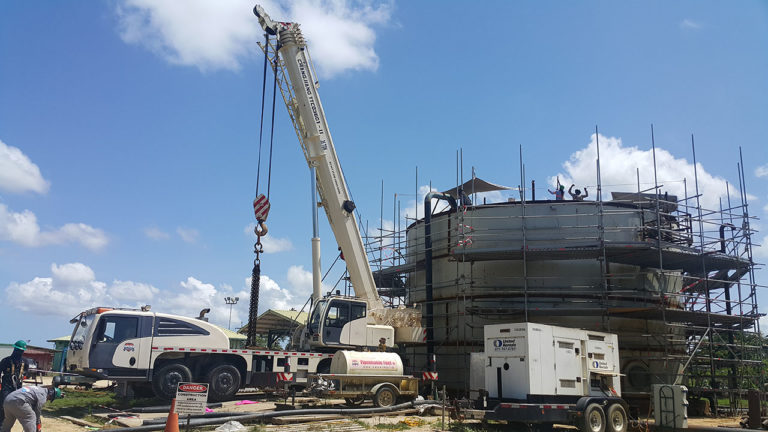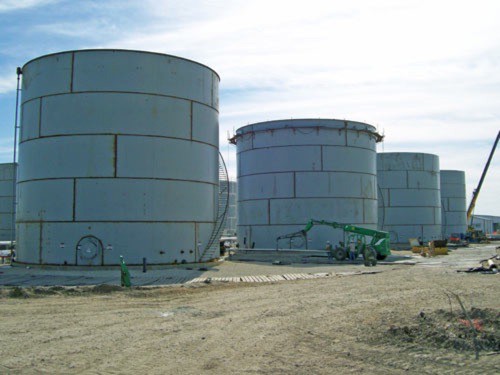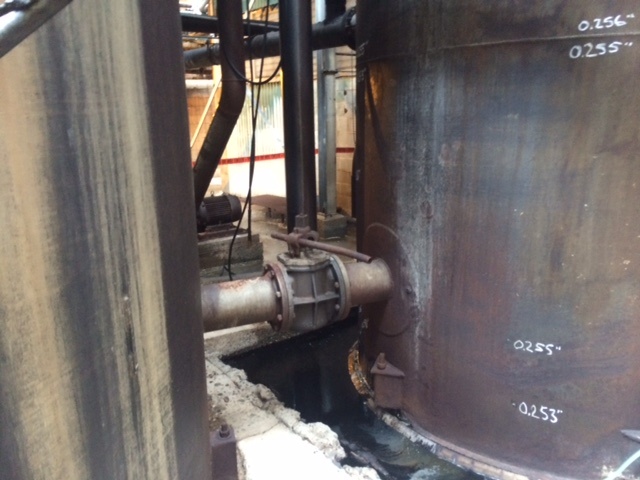Professional API 650 Welding Inspection Methods for Quality Assurance
A Detailed Consider the Installment Process of Welding Examination Techniques
Welding assessment is a vital procedure that ensures architectural honesty and security. The installment of evaluation strategies involves a number of systematic actions, each indispensable to accomplishing trustworthy results. From preparation and device selection to carrying out aesthetic and non-destructive examinations, each phase demands cautious focus. Comprehending these treatments can greatly improve quality control in welding projects. What challenges develop in applying these strategies, and how can they be effectively dealt with?
Recognizing the Relevance of Welding Inspection
Welding assessment is a crucial element of making sure architectural stability and safety and security in construction and manufacturing processes. This practice entails reviewing bonded joints for defects, guaranteeing that they meet particular requirements and guidelines. By methodically assessing weld high quality, inspectors can recognize concerns such as splits, gaps, and incomplete blend, which can endanger the stamina and durability of structures.
The value of welding inspection expands past prompt security concerns; it aids protect against pricey failings and potential dangers in the long-term. Efficient evaluation techniques foster compliance with sector criteria, consequently improving the overall reliability of welded components. Additionally, a durable evaluation process adds to keeping the online reputation of suppliers and home builders, as it guarantees clients of the top quality of their jobs. Inevitably, recognizing the significance of welding inspection is critical for promoting safe building and construction methods and ensuring the long life of important framework and items.
Selecting the Right Devices for Evaluation
When choosing the appropriate tools for examination, it is necessary to ponder the particular needs of the welding process and the materials included. Numerous evaluation approaches, such as aesthetic, ultrasonic, and radiographic testing, require unique tools tailored to their special needs. For visual evaluations, devices like magnifying glasses and calipers are essential for evaluating weld quality. Ultrasonic screening calls for specific tools capable of transmitting and getting audio waves to identify inner defects. Radiographic testing, on the various other hand, makes use of X-ray or gamma-ray sources along with delicate film or electronic detectors to expose incongruities.
In addition, personal safety equipment (PPE) is vital to ensure the security of inspectors throughout analyses. Picking the right devices not only boosts the precision of assessments however also contributes to the overall integrity and safety of the welding project. Subsequently, a complete understanding of readily available devices and their applications is imperative for effective welding examination.
Planning for the Inspection Refine
Before initiating the inspection procedure, it is important to develop a detailed strategy that describes the scope and objectives of the assessment. This plan needs to include specific criteria that specify what makes up acceptable high quality in the welding work being inspected. Recognizing the appropriate codes and standards is essential, as they will guide the inspection requirements and methodologies.
In addition, workers involved in the evaluation must be effectively trained and licensed in welding assessment techniques to ensure reliability and accuracy. A list can be useful in organizing the different facets of the evaluation, varying from equipment preparedness to environmental problems that can affect the evaluation.

Lastly, logistical factors to consider such as organizing, readily available resources, and interaction in between group participants need to be resolved. By preparing methodically, assessors can boost the effectiveness of the evaluation and guarantee that all vital elements are properly taken into consideration prior to continuing with the examination itself.
Performing Aesthetic Examinations

Carrying out visual assessments is an essential action in the welding examination process, needing careful prep work to guarantee efficient examination. Inspectors have to recognize with vital flaw indications that can indicate prospective concerns in weld quality. By concentrating on these aspects, one can enhance the general dependability of the inspection results.
Planning For Visual Inspection
Aesthetic evaluation acts as an essential primary step in the welding evaluation process, ensuring that any prospective defects are determined early (API 650 Welding Inspection). Proper preparation is crucial for effective visual inspection. Examiners need to begin by examining pertinent documents, including welding treatments and specs, to understand the job needs. They should gather essential devices, such as magnifying glasses, flashlights, and proper individual protective tools (PPE) An extensive assessment of the examination area is important; examiners must validate it is cost-free and tidy of blockages. In addition, it is necessary to establish excellent lights problems to boost presence of welds. By taking these primary actions, inspectors can create an environment conducive to identifying discrepancies and assuring the stability of the welded structures
Key Defect Indicators
A comprehensive understanding of vital issue indicators is vital during visual evaluations to ensure the quality and safety of welded joints. Examiners need to concentrate on certain signs such as cracks, porosity, damages, and insufficient blend. Splits may appear as sharp lines and can endanger architectural honesty. Porosity shows up as little holes that can damage weld toughness. Undercuts, which are grooves along the weld edge, can cause tension focus. Insufficient fusion suggests that the weld steel did not appropriately bond with the base product, resulting in a weak joint. By systematically identifying these issues, examiners can ascertain conformity with sector standards and enhance the general integrity of welded structures, ultimately adding to more secure operational problems.
Carrying Out Non-Destructive Testing Strategies

Many non-destructive testing (NDT) methods are integral to ensuring the integrity of welded frameworks without jeopardizing their capability. These techniques permit examiners to review weld top quality and discover issues without triggering damage to the products being evaluated. Typical NDT strategies include ultrasonic testing, radiographic screening, magnetic bit screening, and color penetrant testing. Each technique offers a particular objective, dealing with different sorts of flaws such as cracks, porosity, or insufficient fusion.
Executing NDT methods calls for an organized strategy, beginning with choosing the ideal approach based on the materials and the nature of the weld. Educating employees in these techniques is vital for precise outcomes. In addition, establishing clear procedures and requirements assurances uniformity throughout the examination procedure. By integrating NDT into the welding evaluation process, companies can improve the dependability of their important site items while minimizing potential risks connected with structural failures. This positive method eventually adds to maintaining safety and security and top quality standards in welded buildings.
Recording and Analyzing Evaluation Results
Reliable paperwork and evaluation of examination outcomes are essential parts of the welding evaluation procedure. Precise documents of inspection findings act as a recommendation for top quality assurance and compliance with market criteria. API 650 Welding Inspection. Examiners need to utilize structured types or digital systems to log information such as the kind of weld, inspection methods used, and any type of discrepancies recognized during the assessment
Once data is collected, thorough analysis is essential. This includes comparing outcomes versus developed criteria to identify trends or recurring problems. Analytical tools may be employed to evaluate problems and analyze their effect on general weld high quality.
Additionally, efficient communication of searchings for to appropriate stakeholders is vital. Reports and recaps need to be concise and clear, highlighting crucial insights and referrals for corrective actions. By systematically recording and examining evaluation results, companies can foster continuous improvement in welding techniques and boost product honesty.
Regularly Asked Questions
What Certifications Are Needed to Come To Be a Welding Inspector?
To become a welding assessor, one commonly requires relevant accreditations such helpful site as AWS CWI, along with experience in welding techniques, understanding of welding codes, and proficiency in examination methods to assure quality and safety and security criteria.
Just How Often Should Welding Inspections Be Carried Out?
Welding examinations need to be performed regularly, normally after each weld is finished, and occasionally during tasks. Elements such as job complexity, market standards, you can try this out and governing needs can affect the frequency of these assessments.
What Is the Expense of Welding Inspection Solutions?
The expense of welding assessment solutions differs significantly based upon elements such as task place, size, and complexity. Typically, costs range from $100 to $150 per hour, with added charges for specialized testing and accreditations.
Are There Certifications for Welding Inspectors?
Yes, there are various qualifications for welding examiners, consisting of those provided by the American Welding Society (AWS) and the International Institute of Welding (IIW) These qualifications ensure examiners possess the required skills and understanding for reliable analyses.

How Do I Pick an Inspection Service copyright?
To pick an inspection provider, one ought to assess credentials, experience, market reputation, and client testimonials. In addition, comparing solution offerings and rates can aid ensure the chosen copyright satisfies certain project requires properly.
Additionally, workers included in the examination should be sufficiently trained and accredited in welding inspection methods to ensure dependability and accuracy. Conducting aesthetic assessments is a crucial step in the welding assessment procedure, calling for mindful prep work to assure reliable analysis. Visual examination offers as an essential initial action in the welding assessment procedure, assuring that any kind of possible flaws are determined early. Efficient paperwork and analysis of evaluation results are essential parts of the welding examination procedure. Welding assessments need to be carried out consistently, normally after each weld is finished, and periodically throughout tasks.